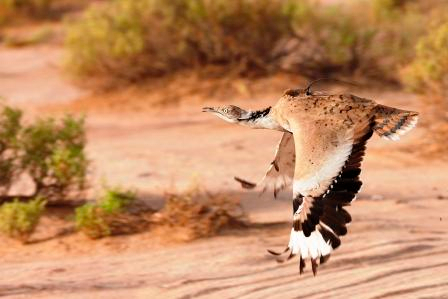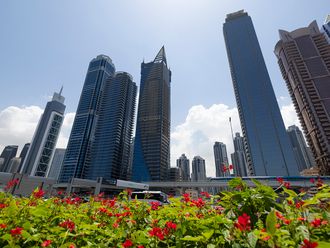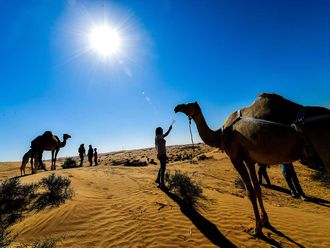
The houbara is quite the sporting bird. Undaunted by the hunting rifles and falcons at the Abu Dhabi International Hunting and Equestrian Exhibition (Adihex), held in September, a few ungainly and beady-eyed houbaras lined up near the fence of their enclosure to check out curious bystanders, barely paying attention to the eggs in the sand behind them.
The prey’s presence at the region’s only exhibition dedicated to hunting, as well as equestrian and outdoor sports is no accident. The houbara bustard, known as khirb (male) or ribd (female) to local falconers, has long been considered a formidable opponent.
The late Shaikh Zayed Bin Sultan Al Nahyan, an avid falconer, led the efforts to preserve the species. According to the International Fund for Houbara Conservation (IFHC), he established a breeding programme at Al Ain Zoo in the late 1970s when he noticed that houbara populations in the wild were declining due to rapid urbanisation, poaching and unregulated hunting.
Falconers are a vital source of information on the houbara population on the ground, and their expertise adds to the understanding of the species.
“About four out of every ten houbaras get to safety even when falcons attack them. They hide behind trees and fight back as well,” says a falcon trainer from Pakistan who claims to have accompanied many of the UAE’s royal hunting parties in Pakistan.
Eyewitness accounts also refer to how it ejects a sticky green slime that can incapacitate or
blind hunters.
Breeding efforts
Aided by technology, conservationists ensure the bird’s population stays on the higher side, and the message to protect it is widely broadcast. According to this year’s figures, IFHC’s production programme raised 25,588 Asian houbara bustards, a 23 per cent increase on the previous season. The year also saw the breeding of 20,426 North African houbaras.
Jordan, Bahrain, Kuwait, Qatar, Yemen and Kazakhstan are working together to release birds bred at IFHC’s facilities. The aim is to release 50,000 birds a year collectively.
Careful genetic vetting to preserve the purity of the species, scientific insemination and artificial incubation at breeding centres must be done to get houbara numbers to reach a satisfactory level — like they once were. In the 19th century it would have seemed like you couldn’t kill enough of them. While native to the Sinai Peninsula, Arabia, Mongolia and India, there are reports of drifters sighted in the UK. But between 1984 and 2004, houbara populations dropped by as much as 50 per cent, and it was classified as vulnerable to extinction. The houbara bustard is now on the International Union for Conservation of Nature’s Red List.
Teaching aids
At Adihex, where a set of perfectly stencilled bird tracks lead visitors inside the stand, Hamda Hamad Al Ameri, Senior Coordinator, Environmental Education, IFHC, told GN Focus, “The falcons hunt the houbara, but for us it is also a part of our culture and heritage. In the past people used the houbara as meat; it was food. But now it is our heritage.”
Her job involves coordinating visits — taking houbaras to schools or inviting students to the centre — and using games, books, apps, movies and traditional storytellers to pass on the message of conservation.
At the exhibition, children familiarised themselves with the bird via an interactive quiz in a kiosk. Students can also download the Mighty Migration app, which traces the path of the migratory bird. Scientists tag the houbaras released into the wild to check if they migrate thousands of kilometres or circle around a 500-kilometre radius before heading back home. A bird is photographed carrying a tiny antenna on its back as it takes flight.
“Our plan is to create more apps,” says Al Ameri. “Children like them and have already found out about migration from one. They check what [the bird] can eat on its path. They play and learn facts. One time, a child told me that the houbara gets all the water it needs from the food it eats. I asked him how he knew this, and he said it was through the app.”
Preserving the best
Mohammad Al Wahedi, Senior Coordinator, Yemen Houbara Project, says satellite tracking technology is particularly useful. A decade has gone into understanding where the birds fly out in winter from the deserts of Abu Dhabi and other parts of Arabia and spend the summer and breed. Diet, flying habits and the species’ behaviour in the lab have all been carefully studied to ensure houbaras bred in captivity are successfully released into the wild.
According to the Environmental Atlas of Abu Dhabi Emirate, launched by the Environment Agency – Abu Dhabi (EAD), a male houbara was fitted with a wire before it left the emirate and travelled 7,000 kilometres through the Strait of Hormuz into Iran, then across the Central Asian states of Turkmenistan, Uzbekistan and Kazakhstan and northern China to the Gobi Desert. Houbaras from different parts of the region favour destinations in Afghanistan, eastern and western Iran, Pakistan and Iraq.
Houbaras bred in captivity are still quick to adapt to their surroundings. “Once, we saw some raptors hovering around and the houbaras we released started to duck and hide behind trees. It was very interesting as we had never taught them this,” says Al Wahedi, the lead ecologist in Yemen.
Smart bird
Clearly, there is something to be said for this inherently smart bird. Locally, there is a 769-square-kilometre protected area for houbaras in Baynunah in western Abu Dhabi. Al Wahedi says the bustard knows instinctively where it is protected. “If you scare a houbara in the areas where hunting is allowed, it will not come back. If it does, it will be cautious. But in places where houbaras feel safe, they might even come close to you.
“This makes some people say the houbara is not wild enough. We tell them, no, the houbara adapts. In places other than the UAE, where people hunt with a gun, you will not see the houbara; you will only find fresh tracks.
“They are like any other living creature — like human beings, for instance. If you feel like you’re in danger you will run away. But if you feel safe you will lie on the beach.”












